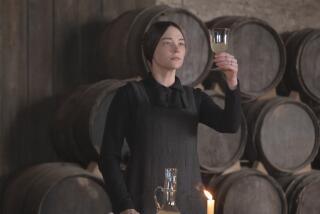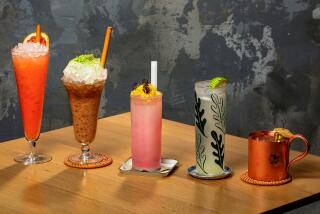Liquid Fire : Brandy, Grappa, Aquavit and Cognac, Those Crystalline Distillations Called âWaters of Lifeâ
Two years ago a young man from Emeryville, on the San Francisco bay, brought me samples of diamond-bright âbrandiesâ that he had distilled from pears, raspberries and Gewurtztraminer grapes. Each was 80-proof and obviously impeccably produced. A lawyer by training, Jorge Rups, now 43, was born in the picturesque city of Colmar in Alsace, into a family with a history of distilling. He sought my assistance in bringing these most artfully made liquors, virtually the soul of such fermented nectars, to my readers. But alas, I was not ready, nor in tune with their raison dâetre. I put these handsome 500-ml bottles of St. George Spirits to one side.
But now, in this apologia, I must also confess that it took me many years to appreciate Cognac. Through countless black-tie dinners of the august Wine & Food Society, I sniffed and sipped the fiery potion, duly warming it first with the palms of both hands, but I formed an unflattering opinion of my senior members, who inevitably sang the praises of these amber draughts with something akin to reverence. Then, one fine day, I was introduced to Paradis, an extraordinary blending of distillations of the grape in Cognac, aged and blended by Hennessy. It may contain as many as 50 different Cognacs, the oldest dating back more than 100 years, the youngest probably 50, all of them from the Grande Champagne region, so called because its chalky soil resembles that of the northern regions where bubbly is made. Paradis is shipped to the United States in very limited quantities and retails for about $150 per bottle.
Paradis, like nearly all other fine Cognacs, is 80-proof. It is as mellow as loveâs finest recollections. Now here is the educational secret of Cognacs: Some are hot, and some are not, though all are 80-proof. Obviously it is not the alcohol that sears the throat, but rather the combination of other elements that age tends to remove: the congeners and aldehydes that make the ethyl alcoholicity less than easy to take.
Only a couple of weeks ago, in Las Vegas, while lunching at Andiamo, the Italian restaurant in the Las Vegas Hilton, I thought it might be time to see why so many people had a fondness for the Italian distillate called grappa, especially one I had seen, at eye-popping prices, on the shelves of Greenblattâs Deli on Sunset Boulevard. Najib Chouafi, Andiamoâs sommelier, formerly of Spago, brought forth Nonino single-grape grappas and a Perrier-Jouet Marc de Champagne. I approached each as carefully as one might a coiled rattlesnake . . . slowly. With sniffs and sips of each thimbleful, I began to find the Nonino Grappa di Picolit ($79.50 per 500-ml flask) enjoyable and fragrant, despite the 100-proof strength, and the single-grape Grappa di Verduzzo ($55) also worthy of further acquaintance, despite its 90-proof volatile force. Splash a little grappa into the pasta e fagioli , and it is peasant fare no longer.
To begin at the beginning, the process of distillation dates all the way back to the ancient Egyptians, but the distillation of wine into spirits, or âbrandy,â dates back only a few centuries. The world of Islam produced the first alembics, the pot-shaped stills for distillation of spirits. Moorish culture moved to Spain, and the first treatise is credited to a Spanish scholar, Arnoldo de Villanova, who taught alchemy in both France and Spain in the 14th Century. He was so awed by the restorative and curative powers of the liquids he distilled from wine that he called them, in Latin, aqua vitae: the âwater of life.â By the 15th Century this magical fluid became known, in direct French translation, as eau de vie, again being âwater of life.â In Scandinavian countries, their potato or grain distillations became known as aquavit. Dutch shipmasters, prevented from shipping barrels of wine because of wars in the 16th Century, opted to concentrate the wine, eliminating the water with heat, restoring it later. So the soul of the wine escaped in steam, condensed and became what they called âbrandewijnâ or âburned wine.â Anglicized over the years, this became âbrandy.â
Centuries later, Italians, seeking to produce a spirit from the pomace, or residue, of wine making, added water to the compressed skins and seeds to prevent scorching when firing up the pot stills. The homeland of this now traditional fiery spirit was northeastern Italy, the Veneto region around the small town of Bessano del Grappa . . . and the name of the product, grappa, was born. The French equivalent of this thrifty distillation, using the pomace as the foundation, rather than the costlier wine, is called marc, pronounced mar.
Eaux de vie from fruit other than grapes were known as early as 1634 when an epidemic of cholera in Alsace was fought by the mass consumption of locally produced kirsch, an eau de vie of black cherries. In Germany and Switzerland, distillations of stone fruits such as cherries and plums were called wasser, as in kirschwasser; made from yellow plums, mirabelle; from violet plums, quetsch. The distillation of red raspberries produces the delicately scented yet still powerful framboise. Eau de vie de Poire, or pear brandy, is made in both France and Switzerland from the Williams pear, which is the Bartlett pear of the U.S., and a spectacularly splendid Williams Pear is made by St. George Spirits in Emeryville ($15 for an 80-proof 500-ml bottle). Applejack in the United States is the same as Calvados of Normandy, France. When a palate cleanser is needed for a formal dinner in parts of France, a small glass of Calvados is served, known as le trou Normand, poetically describing the âwellâ it burns on the way down.
All of these eaux de vie are bottled without aging, almost directly from the stills, as colorless liquids of relatively high proof. Only the French marc is aged traditionally in wood, and hence has some tinge of golden color. Marc de Bourgogne may have a few years of aging, distinguishing it easily from grappa; Marc de Champagne is often more delicate by its double distillation in interconnected pots called alembics a vases.
This spring I was in Alsace with my students on a field tour. At lunch with the Trimbach family in Ribeauville, the meal concluded with a serving of their own Marc dâAlsace Gewurtztraminer. It was fabulous, and will one day it will be available in this country.
Earlier this year, on our field tour to Monterey County, high up in the Santa Cruz Mountains at the Bonny Doon Vineyard of Randall Grahm, we had preview sips of his own grappa or marc, a distillation of the pomace from his own Muscat Canelli Vin de Glace. Bonny Doon Marc de Muscat marc brandy ($10 for 375 ml and $18 for 750 ml) will be released in September at 90-proof, and it is well worth waiting for.
For your own appreciation of aqua vitae, known variously as brandy, eau de vie, marc or grappa, pour a cautious ounce into a wineglass. Hold it to the light, observe its brilliance. Sniff it once, lightly, pause for reflection, sip it, put the glass down and then think about it. Or talk about it. With the second sip, swish it around the mouth so that it covers the taste buds. Notice all the elements that address the palate. Is there any fruit or aroma reaching the palate? Anything harsh? Unpleasant? Smooth? The presence of oak incense, or absence of it? Is it round in taste? Clean? Beyond the obvious alcohol, these subtle differences become the character, wonder and artistry of each distillation.
Raymond Lully, a pupil of Villanova in a Catalan monastery, was absolutely certain that aqua vitae was âdivinely inspired.â Our own appraisal is ready to admit the miracle of fermentation as a gift of heaven, but we must give man full credit for the science of distillation, the product to be used with reason and moderation and consequent joy, bringing remarkable distinction to a simple fruit cup or sherbet, and inspiration to post-prandial hours of candlelight conversation.
More to Read
Eat your way across L.A.
Get our weekly Tasting Notes newsletter for reviews, news and more.
You may occasionally receive promotional content from the Los Angeles Times.








